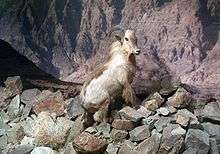Arabian tahr
| Arabian Tahr | |
|---|---|
 | |
| Scientific classification | |
| Kingdom: | Animalia |
| Phylum: | Chordata |
| Class: | Mammalia |
| Order: | Artiodactyla |
| Family: | Bovidae |
| Subfamily: | Caprinae |
| Genus: | Arabitragus Ropiquet & Hassanin, 2005 |
| Species: | A. jayakari |
| Binomial name | |
| Arabitragus jayakari (Thomas, 1894) | |
| Synonyms | |
|
Hemitragus jayakari | |
The Arabian tahr (Arabitragus jayakari) is a species of tahr native to Arabia. Until recently, it was placed in the genus Hemitragus, but genetic evidence supports its removal to separate monotypic genus.
The Arabian tahr is the smallest species of tahr. The animal is of stocky build with backward-arching horns in both sexes. Males are much more robust than females. Its coat consists of a long, reddish-brown hair, with a dark stripe running down the back. Males possess the most impressive manes which extend right down the back and grow longer, based on the age. In the oldest males the muzzle darkens to black and the eye stripes also darken. As with most mountain goats and sheep, it has rubbery hooves to provide balance and traction on the steep, rocky slopes.
Habitat and range
The Arabian tahr lives on steep rocky slopes of Hajar Mountains in the Sultanate of Oman, and the United Arab Emirates at altitudes of up to 1,800 meters above sea level.
Taxonomy
The species was first described from specimens obtained by Dr. A.S.G. Jayakar from Jebel Taw and originally given the name of Hemitragus jayakari.[2] It was separated into the newly created genus Arabitragus on the basis of a study on the molecular phylogeny of the group in 2005.[3]
Biology
Unlike other species of tahr, the Arabian tahr is solitary or lives in small groups consisting of a female and a kid, or a male. And instead of forming herds during seasonal ruts, reproduction occurs in small, dispersed family units. There are reports of births occurring throughout the year, and gestation lasts from 140–145 days.
Diet
These animals are usually browsers, feeding on grass, shrubs, leaves, and fruits of most trees. They are highly dependent on water and need to drink every two or three days during summer. They would descend from their point of elevation to drink from river courses known as wadis, and would travel to new areas when water dries up.
Threats
The Arabian tahr is endangered due to intense overgrazing, poaching, and habitat destruction. In Oman, a recent increase of human migration to urban areas has resulted in domestic goats becoming feral and foraging in places which were once strictly the tahr's home. Habitat degradation is also another major threat, due to construction of roads, buildings, and mineral extraction. Also, poaching often occurs when the animals descend down from the mountains for a fresh drink.
Conservation
In 1973, efforts were planned to protect the Arabian tahr. And in 1975, it was granted in the Hajar Mountains. In 1980, a captive breeding program was set up at the Omani Mammal Breeding Center in order to reintroduce captive-bred individuals back into the wild. There are now three institutions involved, one in Oman and two in UAE. Sadly, many people seem to be unaware about the tahr's grave situations, leading to other conservation initiatives to focus on the publicity and educational campaigns to raise the animals profile. In April 2009, the Wadi Wurayah Fujairah preserve was set aside by royal decree in the United Arab Emirates for the protection of the Arabian Tahr.[4]
References
- ↑ Insall, D. (2008). Arabitragus jayakari. In: IUCN 2008. IUCN Red List of Threatened Species. Retrieved 5 April 2009. Database entry includes a brief justification of why this species is of endangered.
- ↑ Thomas, Oldfield (1894). "On some specimens of mammals from Oman, S.E.Arabia": 448–455.
- ↑ Ropiquet, A. & Hassanin, A. 2005. Molecular evidence for the polyphyly of the genus Hemitragus (Mammalia, Bovidae). Molecular Phylogenetics and Evolution 36(1):154-168
- ↑ http://www.panda.org/wwf_news/news/?uNewsID=163161 Arabian Tahr Gets Royal Protection
